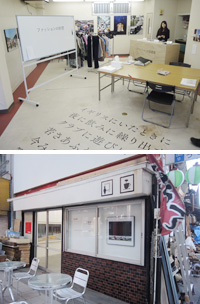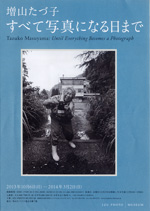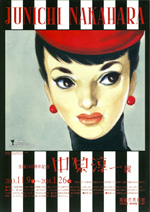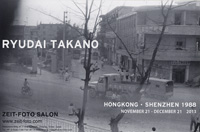 |
Picks is a monthly sampling of Japan's art scene, offering commentary by a variety of reviewers about exhibitions at museums and galleries in recent weeks, with an emphasis on contemporary art by young artists. |
 |
 |
 |
15 January 2014 |
 |
| 1 | 2 | |
 |
|
 |
 |
|
|
 |
 |
 |
 |
| The Flower with the Color of Wind -- dialogues for the future |
| 26 October 2013 - 26 January 2014 |
Arts Maebashi
(Gunma) |
 |
| A brand-new cultural facility that opened last October in downtown Maebashi, the capital of Gunma Prefecture, Arts Maebashi has teamed up in this inaugural show with local art projects utilizing vacant venues scattered throughout the city. The central motif is a "dialoging" by contemporary artists with the work of Maebashi-related creators in various fields -- fine arts, literature, music, and science. |
|
 |
|

|
 |
 |
 |
|
Tazuko Masuyama: Until Everything Becomes a Photograph |
| 6 October 2013 - 2 March 2014 |
Izu Photo Museum
(Shizuoka) |
 |
| Known as the "Camera Grandma," Masuyama did not begin her photography career till she was 60, spurred by government plans to build a dam that would submerge her home village of Tokuyama, Gifu Prefecture, where she had spent her entire life. Her vast trove of snapshots, which she took continuously until her death at 88 in 2006 (the dam was completed in 2008), are not only the sole remaining record of life in Tokuyama; they provoke contemplation of issues ranging from the nation's public-works binge to urbanization and the abandonment of the countryside, the long-term impact of war (Masuyama's husband was lost in action in Burma), and of course the relationship between man and nature. |
|
|
 |
 |
|
Junichi Nakahara: 100th anniversary of birth |
|
9 November 2013 - 26 January 2014
|
|
Takasaki Museum of Art
(Gunma) |
 |
| Through his work as a girls' magazine editor and artist in both the prewar and postwar years, Nakahara (1913-83) won legions of female fans for the diverse aesthetics he brought to the worlds of fashion, interior design, and lifestyle. This retrospective showcases an oeuvre that includes magazine covers, illustrations, paintings, dolls, and even dresses. |
|
|
|
|
|
|
|

|
 |
 |
|
|
|
|
|
 |
|
|
|
|
 |
 |
|
| Ryudai Takano: Hong Kong - Shenzhen 1988 |
| 21 November - 21 December 2013 |
Zeit-Foto Salon
(Tokyo) |
 |
| This series of 45 photos commemorates the unregulated architecture of Hong Kong and its mainland neighbor, the industrial hub of Shenzhen. Particularly evocative are Takano's shots of Kowloon's notorious Walled City in 1988, when it had just been slated for demolition, as well as Shenzhen's factories and apartments. Only 25 at the time, Takano captured these images with a cool, neutral eye that imbues the structures with a distinctive presence. Also of interest is the contrast between this "early period" of Takano's work and his later output. |
|
 |
 |
 |
|
| Hitoshi Uemoto: Marine Area |
| 20 November - 3 December 2013 |
Ginza Nikon Salon
(Tokyo) |
 |
| Behind these deceptively lyrical images of the island of Otsu-shima and its environs lies a dark history: the island was the training base for young soldiers recruited to serve as "human torpedoes" (Kaiten) in the last desperate days of World War II. Shooting on his home turf (Tokuyama Bay in Yamaguchi Prefecture), Uemoto wills himself to confront the tragedies of the past even as he depicts the Seto Inland Sea in the tranquil present. |
|
|
|
|
 |
|
|
 |
|